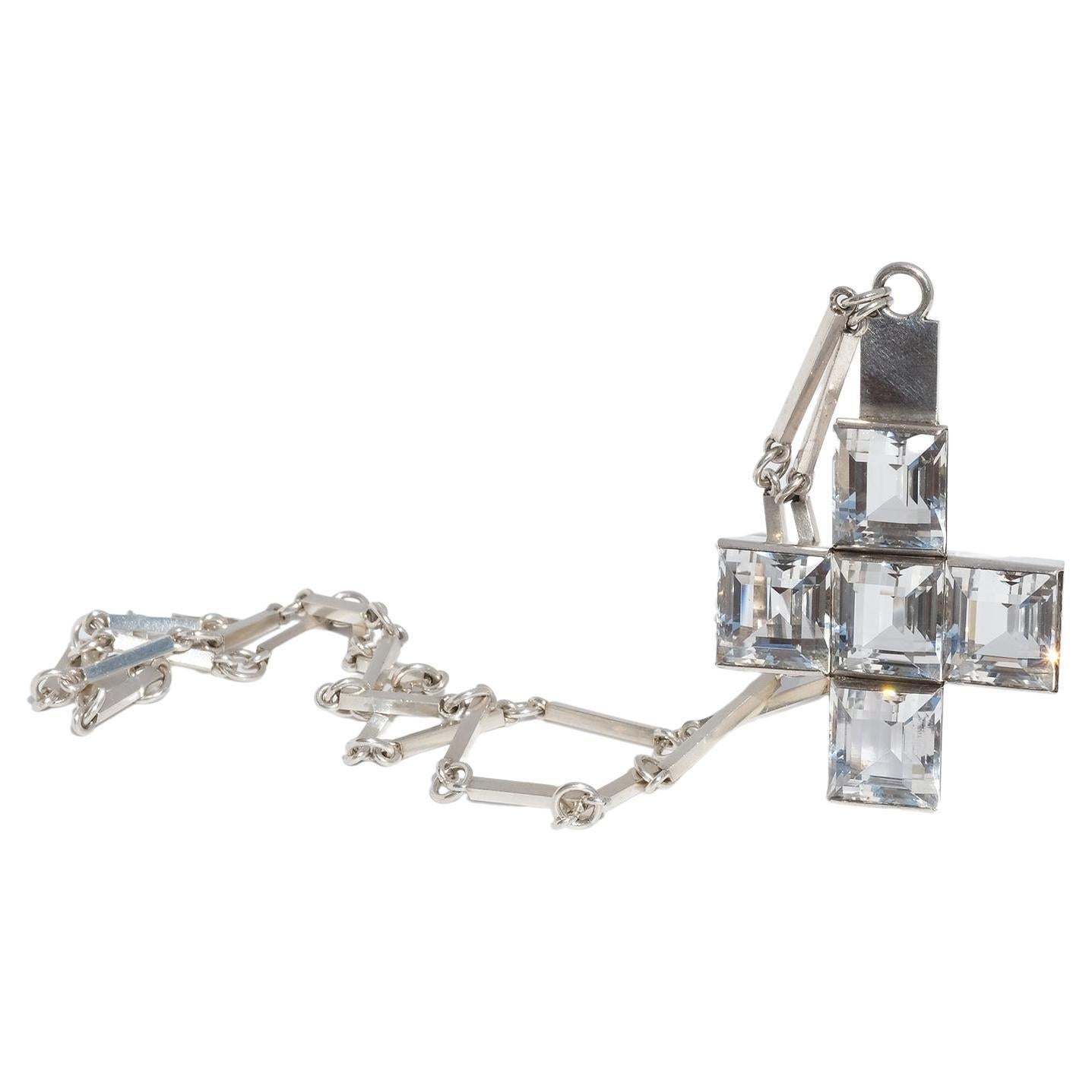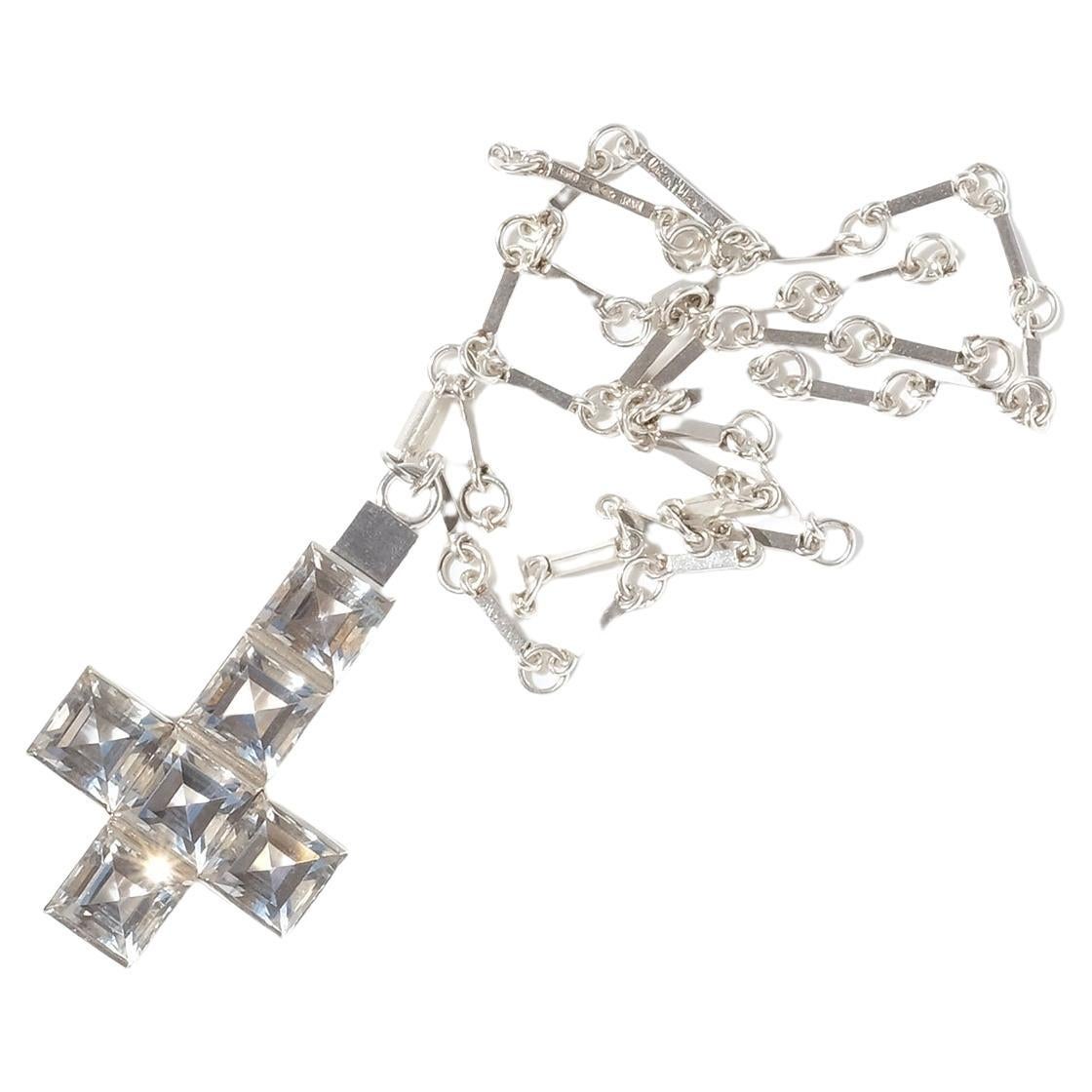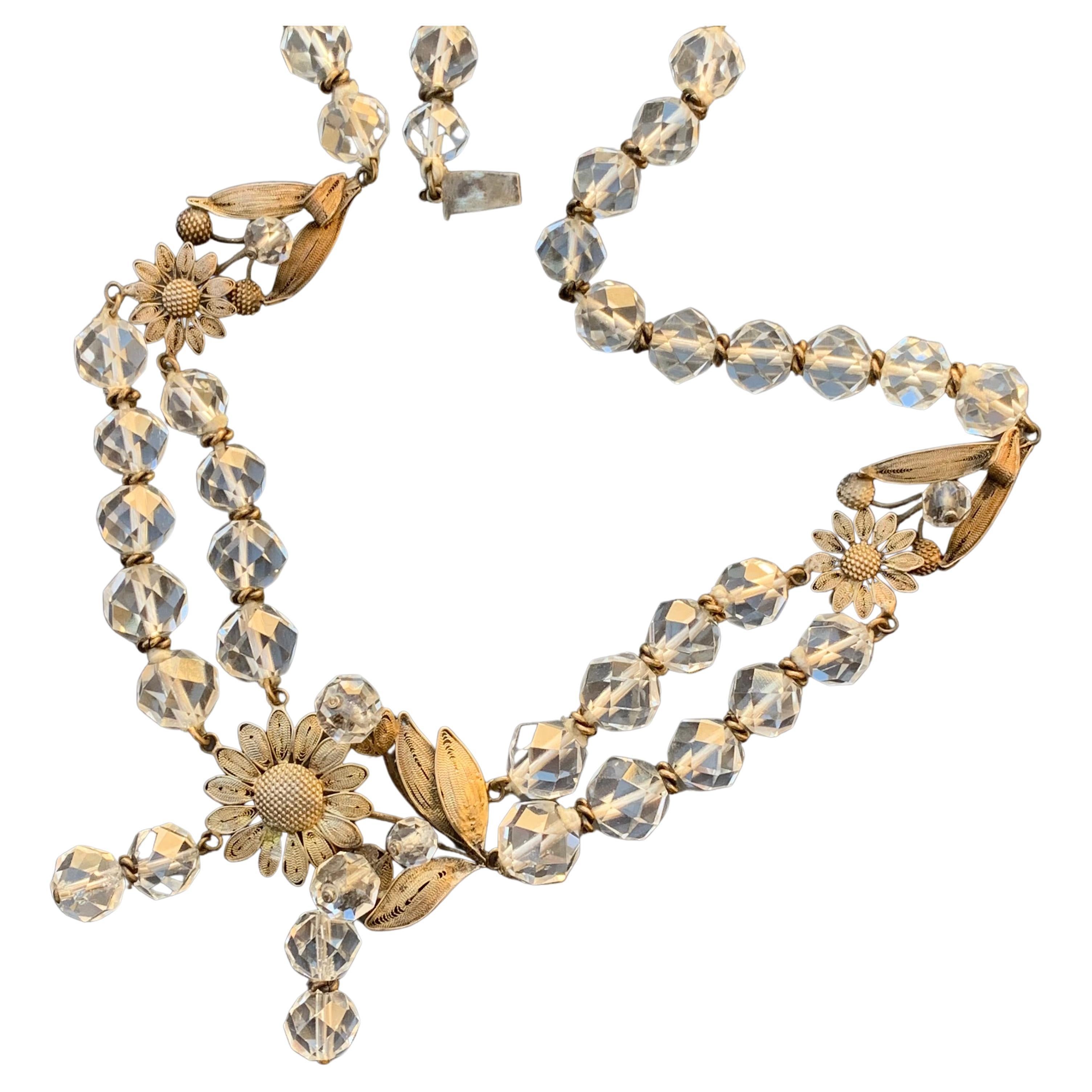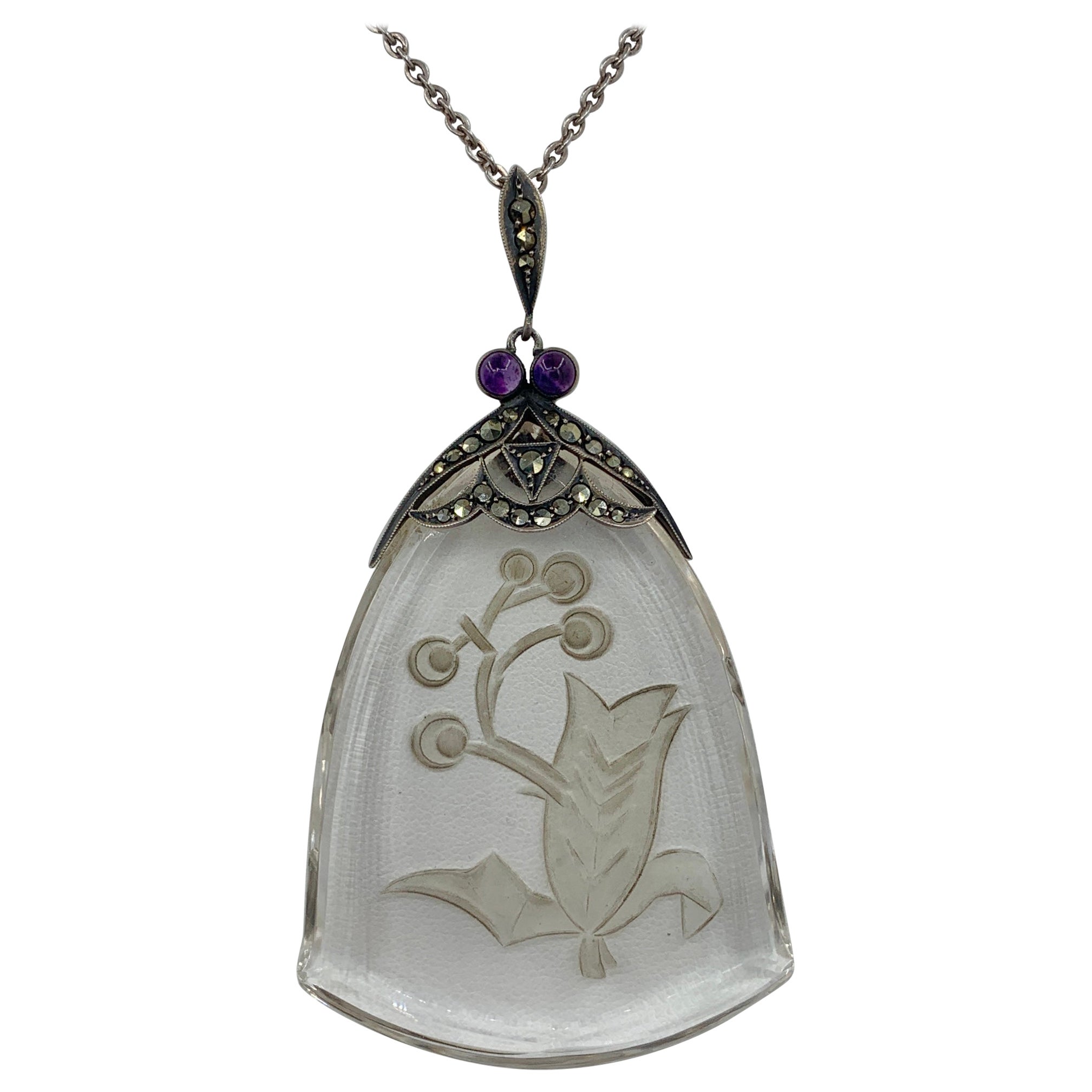Items Similar to 1937 Art Deco 85 carat rock crystal silver necklace by Wiwen Nilsson
Want more images or videos?
Request additional images or videos from the seller
1 of 12
1937 Art Deco 85 carat rock crystal silver necklace by Wiwen Nilsson
About the Item
Silver and approx 85ct rock crystal. Signed and dated 1937. The pendant is 6,7 cm long on a
59 cm long chain.
Wiwen Nilsson (1897-1974) - An Art Deco Silversmith in the Age of Modernism.
Wiwen Nilsson was born in Copenhagen, Denmark in 1897. Born as Karl Edvin, but since he did not like his christening name, he was, within the family, called Wiwen. He was the son of Karolina and Anders and grew up with his sister Edith. In 1897 the family moves to Lund, Sweden when the father takes over the gold and silversmith company J.P. Hasselgren & Son.
In 1906, Wiwen began at Katedralsskolan in Lund and finished school when he graduated fifth grade in 1912. It was common to continue up to sixth grade and then high school, but Wiwen who does not thrive in a school environment wants to become a pianist or aviator instead. However, as the father is a recognized jeweler and court supplier, the son's career is already marked. Instead, he embarks on an educational journey with the goal Königliche Zeichenakademie in Hanau am Main, Germany. The school is Germany's oldest and most prestigious goldsmith's school. Wiwen enrolled on the fourth of August in 1913 and studied drawing, workshop work, engraving and hammering work. The education comes to an abrupt end with the outbreak of the First World War in 1914, and he instead continues his education in his father's workshop, where he stays until 1919. He does, however, make two breaks, the first quarter of 1917 he enrolled at the Technical Society's School in Copenhagen where he studied modeling, among other things, and in 1917-1918 he did his military service in Stockholm. In 1919 he applied for and received his companion letter, at the same time he received the Swedish Craft Organization's large medal in silver for his professionalism.
In 1920 he is again at the school in Hanau, Germany where he stays until 1921 and practices with the jewelry company Chr. Kissling also in Hanau. At school, he mainly studies drawing and chiseling, a type of relief technique that was very popular during the 17th century. Wiwen is driven by his own design language and thinks that the prevailing technique under the influence of Danish designers is a setback in the development of chiseling. During his time in Hanau, he visits several arts and craft exhibitions and comes into contact with the Wiener Werkstätte and the Wiener Werkbund, among others. At the same time as he is studying, he writes travel stories where it emerges that he believes that Sweden's conservatism inhibits the development of arts and crafts, something he himself wants to change.
Back in Sweden in 1921, he was appointed the company's artistic designer. In 1923, the company participates in the Gothenburg exhibition, but here Wiwen receives devastating criticism. His creations are considered ugly and meaningless, a critic writes that it is a typical case of poor material sense.
In 1924, Wiwen Nilsson travels to Paris. Just like in Hanau, he studies chiseling, silver, drawing and modeling at the Académie de la Grande Chaumiére (now Académie Charpentier). One of France's foremost art schools where, among others, Siri Derkert (1888-1973) and Bror Hjorth (1894-1968) have also studied. In Paris he became acquainted with Georg Jensen (1866-1935), in whose workshop he chiseled for a period. He also meets and hangs out frequently with Jules Schyl (1893-1977) and Gösta Adrian-Nilsson, GAN (1884-1965). The meeting with GAN becomes extremely important and came to influence and refine Wiwen's own design language and together they hold a joint exhibition in 1925 in Lund.
From 1925 until the end of the 1920s, Wiwen Nilsson produces a large amount of church silver. He designs and manufactures for, among others, Allhelgonakyrkan in Lund, Knästorps and Tottarps kyrka in Skåne. In total, Wiwen's workshop manufactures 677 objects for churches, of which 483 are found in churches within the diocese of Lund and 194 in other Swedish churches. Some are also sent internationally to the Church of Sweden in Paris, Berlin, Copenhagen and churches in West Germany, Iceland and to Zululand in South Africa. His church silver unmistakably bears the same design language as his profane works. All with the same angular but harmonized and modernist shapes, not infrequently his vessels like jugs and lid boxes are often hexagonal or octagonal.
In 1925 he participated in the Exposition Internationale des Arts Décoratifs et Industriels à Paris (World Exhibition) where he received a gold medal in Class 10, the category for crafts and art industry in metal. Other exhibitors included C.G. Hallbergs Guldsmeds AB and Jacob Ängman in Stockholm. With the successes after the exhibition, Wiwen and his company were invited to exhibit at two exhibitions, in Gothenburg and Zurich in 1926 and in the Swedish Handicraft Association's exhibition at the Metropolitan Museum in New York in 1927. The same year (1927) Wiwen takes over his father's business in Lund for that the year after 1928 be appointed court jeweler and open branch in Malmö. After he took over the company, Wiwen's influence is clearly visible in the company's production, his design language flourishes and is included in many of the new products that are marketed. The company is now also starting to produce a large number of prizes, primarily athletic prizes in the form of trophies of various kinds. The Lund Cup from 1929 can be mentioned here, which was shown at the Stockholm Exhibition in 1930.
At the exhibition, Wiwen receives mainly positive reviews and the opportunity can be seen as a great success for himself and the company, this will be his breakthrough in Stockholm. The National Museum in Stockholm decides, among other things, to buy two of his exhibited objects, an octagonal vase and a hexagonal tea box with an ebony knob. His most modernist and technically most advanced object at the exhibition is a hexagonal wine jug, also this one with a knob and grip in ebony. At the same exhibition, he also shows a large number of jewelry. These are mainly characterized by their geometric shapes and the use of rock crystal. His jewelry had an international impact at the World's Fair in New York in 1939. The success led, among other things, to the director of The Swedish Arts and Crafts Company Tage Palm (1892-1959) opening a store on 57th Street in New York selling exclusive sculptures of Carl Milles, glass by Orrefors, and Wiwens jewelry.
During the 1950s and 60s, Wiwen Nilsson continued to create and maintain frequent contact with GAN. At the H55 exhibition in Helsingborg in 1955, GAN participates with, among other things, a tapestry in interaction with one of Wiven's sculptures. During the same decade, Wiven was alone in Sweden in letting East Asian art influence his jewelry work. Worth mentioning are a number of brooches designed as cranes.
Wiwen died after a period of illness on January 8, 1974 – 77 years old.
- Creator:
- Metal:
- Stone:
- Stone Cut:
- Weight:85 ct
- Dimensions:Length: 2.64 in (67 mm)
- Style:
- Place of Origin:
- Period:
- Date of Manufacture:1937
- Condition:Replacements made: Replacement lock. Wear consistent with age and use.
- Seller Location:Malmö, SE
- Reference Number:1stDibs: LU3148217481422

About the Seller
5.0
Recognized Seller
These prestigious sellers are industry leaders and represent the highest echelon for item quality and design.
Platinum Seller
These expertly vetted sellers are 1stDibs' most experienced sellers and are rated highest by our customers.
Established in 2015
1stDibs seller since 2022
31 sales on 1stDibs
Typical response time: 1 hour
- ShippingRetrieving quote...Ships From: Malmö, Sweden
- Return PolicyA return for this item may be initiated within 3 days of delivery.
More From This SellerView All
- Art Deco aquamarine, diamond and onyx pendant necklaceLocated in Malmö, SEImmerse yourself in our drop of seawater. Aquamarine & Diamond and onyx pendant. Height of Aqua approx 2,5cm / 1 inch, 13mm / 0.05 inch wide. Total length of pendant 4 cm / 1,57 i...Category
Early 20th Century European Art Deco Drop Necklaces
MaterialsAquamarine, Diamond, Onyx
- Cartier carved rock crystal “Door Knocker” earrings circa 1970By CartierLocated in Malmö, SEA pair of timeless Cartier carved rock crystal “Door Knocker” earrings - transparent yet luminous! This transparent colorless form of quartz conjures u...Category
Vintage 1970s French Modern Hoop Earrings
MaterialsCrystal, Diamond, Rock Crystal, 18k Gold, Yellow Gold
- 19th century rock crystal and carved smoky quartz demi-parureLocated in Malmö, SEhis unusual and lovely victorian set of faceted rock crystals and carved smoky quartz was made in the second half of the 19th century. Natural rock crystals are saluted for its way of bending the light into a “pool” of light around the wearer. They are absolutely magical and look fabulous when worn. Rock crystal is the clear transparent variety of quartz (silicon dioxide) and has a MOHS hardness rating of 7. This makes them harder than, say, opal but softer than emerald (7.5) and topaz (8). Featuring two genuine rock crystal briolettes. The beautiful briolettes are pear shaped and faceted. They sparkle beautifully. Truly special heirloom earrings...Category
Antique Late 19th Century Dangle Earrings
MaterialsCrystal, Quartz, Rock Crystal
- Antique victorian yellow gold collar necklaceLocated in Malmö, SEA special and very modernistic design for a Victorian piece! Antique collar necklace in yellow 14 karat gold. Unmarked, lenght of necklace 39.0cm, weight 25.3 gramCategory
Early 20th Century English Late Victorian Pendant Necklaces
MaterialsGold, Yellow Gold, 14k Gold
- Italian Art Deco diamond, emerald and ruby earringsLocated in Malmö, SEBig, a bit whimsical, rather naïve and utterly charming Italian earrings are all that! Elegant scrolls embellished with calibré cut emeralds, rose and single cut diamonds and three ruby beads each. 18 karat gold and silver with a pin and clip clasp...Category
Vintage 1920s Italian Art Deco Stud Earrings
MaterialsDiamond, Emerald, Ruby, 18k Gold, Silver
- Art Deco diamond and ruby ringLocated in Malmö, SEThis dramatic navette ring is quite the spectacular find! Sleek and slender, this romantic gem has a delightful and intriguing design. The diamond-sprinkled openwork navette shape f...Category
Early 20th Century Italian Art Deco Cocktail Rings
MaterialsDiamond, Ruby, 18k Gold, White Gold
You May Also Like
- Silver Necklace with Rock Crystal Cross, Made by Wiwen Nilsson in 1939, SwedenBy Wiwen NilssonLocated in Stockholm, SEThis sterling silver necklace shows upon typical Wiwen Nilsson characteristics; the pendant which is shaped as a Greek cross with square rock crystals, and the ring and bar chain. ...Category
Vintage 1930s Swedish Chain Necklaces
MaterialsRock Crystal, Silver
- Necklace Made by Wiwen Nilsson in 1938, SwedenBy Wiwen NilssonLocated in Stockholm, SEThis sterling silver necklace shows upon typical Wiwen Nilsson characteristics; the geometric lines, the clean-cuts, the modern design and brushed silver, the square faceted cut rock...Category
Vintage 1930s Swedish Chain Necklaces
MaterialsRock Crystal, Silver
- Art Deco Silver and Crystal Roses NecklaceLocated in Boston, LincolnshireA Spectacular Art Deco c.1920s Chromium plated Solid Silver and Crystal Roses necklace. Length 16 1/2" Drop 55mm Width of the pendant 21mm Unmarked, tes...Category
Vintage 1920s Unknown Art Deco Pendant Necklaces
MaterialsCrystal, Silver
- Art Deco Chinese Gilt Sterling Silver Rock Crystal Choker NecklaceLocated in Plainsboro, NJVintage handmade /hand faceted Art Deco Chinese export Gilt Sterling Silver Rock Crystal Choker Necklace with filigree tongue and box clasp . Very well made piece with beautiful det...Category
Vintage 1920s Chinese Art Deco Chain Necklaces
MaterialsCrystal, Rock Crystal, Sterling Silver
- Art Deco Flower Necklace Rock Crystal Amethyst Marcasite Sterling Silver RareLocated in New York, NYTHIS IS A WONDERFUL AND VERY RARE MUSEUM QUALITY ORIGINAL ART DECO PENDANT NECKLACE WITH AN EXTRAORDINARY FLOWER MOTIF CARVED ROCK CRYSTAL PENDANT SET...Category
Early 20th Century Unknown Art Deco Pendant Necklaces
MaterialsAmethyst, Marcasite, Rock Crystal, Silver, Sterling Silver
- 10.83 Carat Total Tahitian Pearl Rock Crystal Diamond NecklaceBy Kiersten ElizabethLocated in Charleston, SCThe blend of Rock Crystal, with it strong distinctive lines, with the ever so classic Tahitian Pearls and Diamonds conjures modernity meets sophistication. Pendant Detail Tahitian ...Category
21st Century and Contemporary American Modern Pendant Necklaces
MaterialsDiamond, Pearl, Rock Crystal, Crystal, 18k Gold, Platinum
Recently Viewed
View AllMore Ways To Browse
Important Art Deco Jewelry
Dior Silver Box
85 Carat
Art Deco Trophies
Art Deco Trophy
Vintage Crystal Cups
Rock Crystal Art Deco Jewelry
Emerald Pendant French
African Emerald
Art Deco Pendant Swedish
1920 Knob
Art Deco Crystal Box
Wine Pendants
Art Deco Pendant Glass German
Sell Something On Here
Military Jewelry Vintage
Large Crystal Pendant Necklace
Art Deco Jewelry With Rock Crystal





